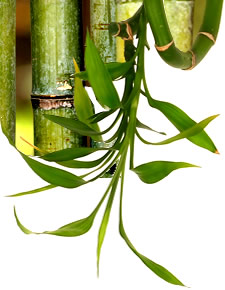

Bamboo Uses |
Culinary uses The shoots (new bamboo culms that come out of the ground) of bamboo, called zhú sǔn (竹笋) in Chinese, are edible. They are used in Asian stir fry, and are available in supermarkets in various sliced forms. However, the shoots of some species contain toxins that need to be leached or boiled out before they can be eaten safely. Pickled bamboo, used as a condiment, may also be made from the pith of the young shoots. The sap of young stalks tapped during the rainy season may be fermented to make ulanzi (a sweet wine), or simply made into a soft drink. Zhúyèqīng jiǔ (竹叶青酒) is a green-colored Chinese liquor that has bamboo leaves as one of its ingredients. Other uses Bamboo forms a very hard wood, especially when seasoned, and is light and exceptionally tough. This makes it useful for many things such as houses (in tropical climates), fences, bridges, walking sticks, furniture, chopsticks, food steamers, toys, construction scaffolding, hats, abaci and various musical instruments such as the shakuhachi, and jinghu. Modern companies are attempting to popularize flooring made of bamboo pieces steamed, flattened, glued together, finished, and cut. However bamboo wood is easily infested by wood-boring insects unless treated with wood preservatives or kept very dry. When bamboo is harvested for wood, care is needed to select mature stems that are several years old, as first-year stems, although full size, are not fully woody and are not strong. Culms may be cut and hollowed into vases or drinkware, tubes, or pipes for liquids. Bamboo canes are normally round in cross-section, but square canes can be produced by forcing the new young culms to grow through a tube of square cross-section and slightly smaller than the culm's natural diameter, thereby constricting the growth to the shape of the tube. Every few days the tube is removed and replaced higher up the fast-growing culm. The fibre of bamboo has been used to make paper in China since early times. A high quality hand-made paper is still produced in small quantities. Coarse bamboo paper is still used to make spirit money in many Chinese communities. The wood is used for knitting needles and the fibre can be used for yarn. A variety of bamboo was one of about two dozen plants carried by Polynesian voyagers to provide all their needs settling new islands; in the Hawaiian Islands, among many uses, 'Ohe (bamboo) carried water, made irrigation troughs for taro terraces, was used as a traditional knife for cutting the umbilical cord of a newborn, as a stamp for dyeing bark tapa cloth, and for four hula instruments - nose flute, rattle, stamping pipes and Jews harp. |
© Copyright yayixm.com All rights reserved. Unauthorized duplication in part or whole strictly prohibited by international copyright law. |
|
|